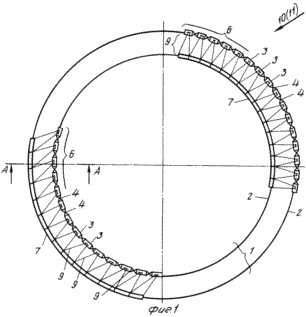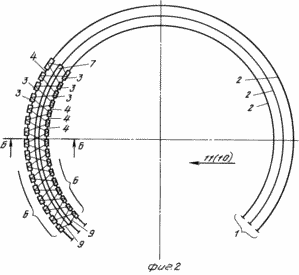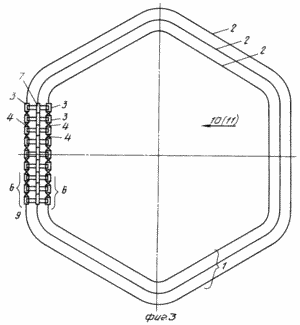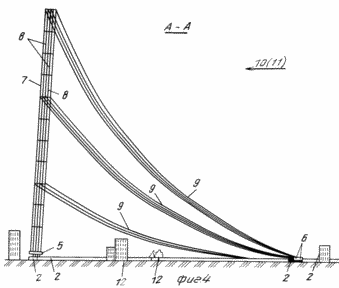| section Home
Production, Amateur Radio amateur Model aircraft, rocket- Useful, entertaining |
Stealth master
Electronics Physics Technologies invention |
space Mystery
Earth Mysteries Secrets of the Ocean Stealth section Map |
|
| Use of material is permitted for reference (for websites - hyperlinks) | |||
Navigation: => |
Home / Products Patents / In the section of the catalog / back / |
|
INVENTION
Russian Federation Patent RU2008519
![]()
DEVICE FOR ENERGY CONVERSION
Name of the inventor: Ovechkin Vladimir Petrovich
The name of the patentee: Ovechkin Vladimir Petrovich
Address for correspondence:
Starting date of the patent: 1990.03.15
Use: in the field of energy, particularly when converting wind and solar energy. The inventive device for converting energy comprises curved bearing track in the form of at least two equidistant paths which are placed support trolley mounted with at least one multisectional frame with a supporting part and with an energy converter arranged along the carrier track movably and its automatic orientation. The new device is the fact that the supporting trolley, equipped with drives connected to each other and form bonds with at least two circuits, arranged to move through the synchronous equidistant paths carrier route. Furthermore, the energy converters are designed as wind and solar conversion means. Equidistant paths are formed as conjugate sections of different curvature. Chains supporting trolleys fitted with the possibility of changing their length by changing the length of their relationship. At least two supporting portions with a frame disposed on the carrier opposite portions of the track. The frame is mounted for deflection its center of mass relative to its fastening locations on the supporting trolley in a direction transverse the carrier path of the track.
DESCRIPTION OF THE INVENTION
The invention relates to power engineering, in particular to wind and solar energy conversion.
Wind power generating apparatus is known [1], consisting of a multi-frame with placed on it working elements of wind flow energy converters, which is mounted on the support trolley to move along a curved path carrier.
Such a device is not sufficiently effective due to the fact that part of the operating elements always is in the frame of the shadow zone, a large mass of moving parts leads to significant frictional energy losses and device occupied ground surface may not be used for other purposes
Known devices for photovoltaic [2] and reflectively-focusing [3] The conversion of solar energy into electric or thermal energy, in which there are no large moving parts, operating elements always turned toward the sun, but a large area of ground surface, occupied by the devices, and can not be used a different purpose.
A device for converting wind energy [4], adopted as a prototype, in which the workers transducer elements are placed on a hard, multiple frame, which is mounted on the support trolley to move along two paths equidistant carrier track when the direction of the wind.
However, this device is insufficiently effective for the following reasons.
Firstly, increasing the wind power converters, not only leads to a significantly higher weight gain multiple-frame, but also to a significant complication of the process of its movement along the carrier track. Furthermore, the possibility for device operation requires a fairly precise alignment of equidistant paths in a horizontal plane and with respect to each other. Second, the surface area of land located within the equidistant paths device, and at some distance beyond them, can not be used for objects of industrial, agricultural and social purposes.
The invention addresses the problem of increasing the efficiency of the resulting increase in capacity of multiple devices, and to improve the efficiency of use of the territory occupied by them at the expense of the possibility of placing it on the other industrial, agricultural and cultural and community purpose.
This object is achieved in that the device for energy conversion, comprising a curved carrier track, comprising at least two equidistant paths placed on them to move the supporting trolley mounted on them with the possibility of automatic orientation and disposed along the carrying route at multisectional least one frame part and a supporting energy transducers mounted on the frame, supporting the trolley and provided with actuators connected to each other to form bonds with at least two chains are mounted for simultaneous movement along paths equidistant carrier track. Furthermore, the energy converters are designed as wind and (or) solar conversion means equidistant paths are formed as conjugate sections of different curvature, and a chain supporting trolley mounted with possibility of changing their length by changing the length of links, at least two carcass with supporting portions located on opposite sites of the carrier track, mounted to the frame deflection its center of mass relative to its fastening locations on the supporting trolley in a direction transverse the carrier path of the track.
The essential distinguishing features for energy conversion devices include the following.
Supporting a multi-truck frame and its supporting parts are connected by links to form at least two chains.
Chains supporting trolleys equipped with actuators mounted for synchronous movement by equidistant paths carrier route.
energy converters in the form of wind and (or) solar converting device.
Equidistant path carrier route in the form of conjugate sections of different curvature.
Chains supporting trolleys fitted with the possibility of changing their length by changing the length of their relationship.
At least two supporting portions with a frame disposed on the carrier opposite portions of the track.
The frame is mounted for deflection its center of mass relative to its fastening locations on the supporting trolley in a direction transverse the carrier path of the track.
 |
 |
 |
 |
 |
FIG. 1 is a diagram of the device for converting energy (top view) with a closed annular track equidistant from the two paths; FIG. 2 - the same, with an open track equidistant from the three ways; FIG. 3 - the same, with a closed track in the form of a polyhedron with rounded sides of conjugation; FIG. 4 - A-A sectional view in FIG. 1 (with a supporting part in the form of one-sided flexible extensions with the slope of the frame with power converters to meet the wind flow); FIG. 5 - B-B sectional view in FIG. 2 (with a supporting part in the form of a double-sided flexible extensions). |
Device for energy conversion comprises a closed (FIGS. 1, 3) or open (Fig. 2) with one carrier Thrace equidistant along the entire length of the two paths installed on land or water. 1 runs on the tracks supporting the carriage 3 has connected communications circuits 4 5, 6, or provided with integrated self-contained actuators (not shown). Chain bearing bogies 5, 6 are mounted with the possibility of changing their overall length by lengthening or shortening the links 4 connecting supporting the carriage 3 in the chain. In the circuits of support trolleys, located on different routes routes are 1, set at least one multiple-frame consisting of two parts - Part 7 in the sections which there are power converters 8 and supporting portion 9 formed in the form of, for example, the flexible extensions system (FIGS. 4, 5). Part 7 carcass energy transducer 8 placed on the chains 5 bearing trolleys and supporting portion 9 frame may be placed on one (FIG. 1) or two (FIGS. 2, 3) circuits 6 bearing bogies positioned respectively on one or both sides with respect to part 7 of the frame.
Section frame part 7 connected to each other and are able to deflect relative to their fixing seats on the supporting trolley in a direction transverse the carrier path of the track, that is towards the wind flow 10 (FIG. 4). As an energy transducer 8 can be applied and wind, and solar energy converters, operating individually or together. The device is equipped with a built-in or separately placed sensors measure the spatial and energy parameters of the wind and the sun 10 11 flows of energy and sensors monitoring parameters of the device nodes associated with the control system. Actuators move the support carriages chains, gears and the orientation of the frame and regulating power converters, collection devices, and the preparation and transfer of energy to the consumer al., And are connected to the control system.
The location of the device area can be placed 12 objects of industrial, agricultural and social purposes.
DEVICE FOR ENERGY CONVERSION WORKS AS FOLLOWS
At the command of the control system in a manual or automated circuit mode 5, 6 supporting bogies 3 move along track 1 located on their frame in a position corresponding to the transverse position of the frame relative to the windshield 10 or sunshine 11 energy flow (FIGS. 1, 2, 3). energy converters 8-oriented control system from the signals and configured for a specific mode of operation, energy flow under the influence or produce electrical energy concentrated solar thermal energy in a particular location area of the device area. Electrical or thermal energy from the transducer is supplied to the common power grid devices in which it is carried out training in the required parameters (frequency, voltage, gender, current, temperature, coolant pressure, etc.) And transfer to the consumer.
The energy produced is used for the needs of the device located in the area of industrial, agricultural and social projects 12 or transferred to other areas. The excess energy can be stored for later use by the application of the relevant accumulating devices, depending on local conditions.
When the direction and intensity of wind flow and sun radiation device management system after processing information from the respective sensor outputs a command to change the frame position not carrying track 1 - synchronously switched actuators move the chains supporting trolleys 5, 6, and the entire frame with the energy transducer is moved to the corresponding portion highway 1, located across the energy flow 10 or 11.
When placed on the frame of wind energy converters are possible, for example, embodiments of the apparatus, providing for allocation on a curved (FIG. 1) or multifaceted (Fig. 3) of the closed (FIGS. 1, 3) or open (Fig. 2), the track 1 of two or more skeletons, some of which are located on the windward side, and the other - on the lee side of the device. Moreover, the supporting portion 9 is located on one frame (FIG. 4) or two (FIG. 5) sides of the frame portion 7 with the power converters. To reduce the load on the flexible extensions of the supporting portion 9 frame part 7 is mounted for movement relative to the center of mass locations fastening sections with an energy converter 8 in the direction towards the wind flow 10, for instance by tilting. The value of the slope depends on the wind load on the frame and provided the change of the extensions 9 frame length. Tilt frame forward wind flow provides decrease (compensation) from the value of the tipping moment acting on the pressure of the wind strength and the frame, respectively, a decrease loads on the stretch of the supporting frame.
When you move the frame on the carrier track 1 with portions of different curvature (Fig. 3) to compensate for the difference in the lengths of equidistant paths (external path length of the inner) supporting trolleys are connected in a circuit 6 via connections 4, having the ability to change the management system team distance between the support trolleys 3. So, if you move the frame on a line equidistant from the three routes of varying curvature (Fig. 2) between the outer bearing bogies way lengthened, shortened inner path, and the path spednem remain unchanged. This is achieved by the arrangement of all three supporting trucks at different ways and associated with one frame section, on a radial line of the curved track and ensured a stable position of the frame in a vertical plane.
The multi-faceted form bearing tracks (Fig. 3), each face of which is equal to or greater than the total length of her disposable frames, allows the most efficient place all frames on the track with respect to the wind flow. This is achieved by the fact that the side of the device and the track located on the frame energy converters are placed perpendicular to the direction of the dominant winds for the area (including "wind rose").
The distortion in the nature of the wind flow shadow frame area located on the windward side of the device, and reducing the energy potential of the frame does not affect the operation located on the same track, but on the leeward side of the apparatus. This is because the distance between the frames can reach several kilometers. With the passage of this distance, the wind flow even at the height of the carcass, measured in tens and hundreds of meters, is fully aligned.
A feature of the device on which there are solar energy converters, is that an open circuit 1 is performed, oriented to the east, south and west, if one frame (Fig. 2) is located on the highway. For mnogokarkasnogo devices with solar inverters closed track is performed.
When placed on the frame and wind, and solar energy converters increased regularity (regularity) of power generation. In the presence of wind wind converters operate, if solar energy flux of solar inverters operate in the presence of wind and solar energy flows run those and others in an optimal ratio.
(56) Author's certificate USSR N 1307082, cl. F 03 D 3/06, publish. 1987.
Copyright certificate USSR N 275249, cl. H 01 L 31/00, publish. 1970.
Copyright certificate USSR N 1272062, cl. F 24 J 2/18, publish. 1,986.
Copyright certificate USSR N 1280180, cl. F 03 D 1/02, publish. 1,986.
CLAIM
1. DEVICE FOR ENERGY CONVERSION, comprising a curved carrier track, including at least two paths equidistant placed on them to move the supporting trolley mounted on them with the possibility of automatic orientation and placed along the carrier track by at least one frame with multisection supporting portion and power converters are mounted on the frame, characterized in that, in order to improve efficiency and use the occupied territory, the support trolley provided with actuators and connected to each other bonds to form at least two chains are mounted for synchronous movement on equidistant paths carrier route.
2. Device according to claim. 1, characterized in that the energy converters are designed as wind and (or) converting solar devices.
3. Apparatus according to claim. 1, characterized in that the equidistant paths are formed as conjugate sections of different curvature, and a chain supporting trolley mounted with possibility to change their length by changing the length of their bonds.
4. The apparatus of claim. 1, characterized in that at least two supporting portions with a frame disposed on the carrier opposite portions of the track.
5. The apparatus of claim. 1, characterized in that the frame is mounted for deflection its center of mass relative to its fastening locations on the supporting trolley in a direction transverse the carrier path of the track.
print version
Publication date 10.02.2007gg




Comments
Commenting, keep in mind that the content and the tone of your messages can hurt the feelings of real people, show respect and tolerance to his interlocutors, even if you do not share their opinion, your behavior in terms of freedom of speech and anonymity offered by the Internet, is changing not only virtual, but real world. All comments are hidden from the index, spam control.